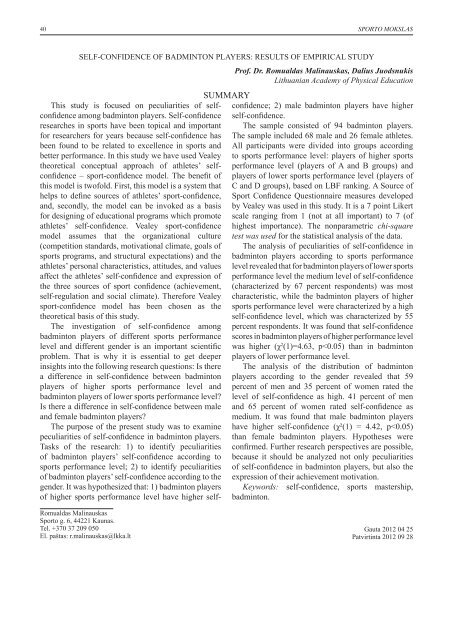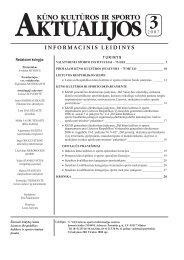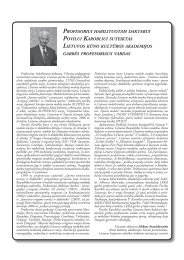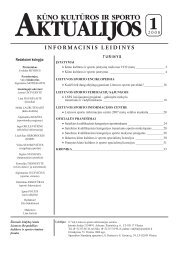Nr. 3 - Lietuvos sporto informacijos centras
Nr. 3 - Lietuvos sporto informacijos centras
Nr. 3 - Lietuvos sporto informacijos centras
Create successful ePaper yourself
Turn your PDF publications into a flip-book with our unique Google optimized e-Paper software.
40<br />
SPORTO MOKSLAS<br />
self-confidence of badminton players: results of empirical study<br />
Summary<br />
Prof. Dr. Romualdas Malinauskas, Dalius Juodsnukis<br />
Lithuanian Academy of Physical Education<br />
This study is focused on peculiarities of selfconfidence<br />
among badminton players. Self-confidence<br />
researches in sports have been topical and important<br />
for researchers for years because self-confidence has<br />
been found to be related to excellence in sports and<br />
better performance. In this study we have used Vealey<br />
theoretical conceptual approach of athletes’ selfconfidence<br />
– sport-confidence model. The benefit of<br />
this model is twofold. First, this model is a system that<br />
helps to define sources of athletes’ sport-confidence,<br />
and, secondly, the model can be invoked as a basis<br />
for designing of educational programs which promote<br />
athletes’ self-confidence. Vealey sport-confidence<br />
model assumes that the organizational culture<br />
(competition standards, motivational climate, goals of<br />
sports programs, and structural expectations) and the<br />
athletes’ personal characteristics, attitudes, and values<br />
affect the athletes’ self-confidence and expression of<br />
the three sources of sport confidence (achievement,<br />
self-regulation and social climate). Therefore Vealey<br />
sport-confidence model has been chosen as the<br />
theoretical basis of this study.<br />
The investigation of self-confidence among<br />
badminton players of different sports performance<br />
level and different gender is an important scientific<br />
problem. That is why it is essential to get deeper<br />
insights into the following research questions: Is there<br />
a difference in self-confidence between badminton<br />
players of higher sports performance level and<br />
badminton players of lower sports performance level?<br />
Is there a difference in self-confidence between male<br />
and female badminton players?<br />
The purpose of the present study was to examine<br />
peculiarities of self-confidence in badminton players.<br />
Tasks of the research: 1) to identify peculiarities<br />
of badminton players’ self-confidence according to<br />
sports performance level; 2) to identify peculiarities<br />
of badminton players’ self-confidence according to the<br />
gender. It was hypothesized that: 1) badminton players<br />
of higher sports performance level have higher selfconfidence;<br />
2) male badminton players have higher<br />
self-confidence.<br />
The sample consisted of 94 badminton players.<br />
The sample included 68 male and 26 female athletes.<br />
All participants were divided into groups according<br />
to sports performance level: players of higher sports<br />
performance level (players of A and B groups) and<br />
players of lower sports performance level (players of<br />
C and D groups), based on LBF ranking. A Source of<br />
Sport Confidence Questionnaire measures developed<br />
by Vealey was used in this study. It is a 7 point Likert<br />
scale ranging from 1 (not at all important) to 7 (of<br />
highest importance). The nonparametric chi-square<br />
test was used for the statistical analysis of the data.<br />
The analysis of peculiarities of self-confidence in<br />
badminton players according to sports performance<br />
level revealed that for badminton players of lower sports<br />
performance level the medium level of self-confidence<br />
(characterized by 67 percent respondents) was most<br />
characteristic, while the badminton players of higher<br />
sports performance level were characterized by a high<br />
self-confidence level, which was characterized by 55<br />
percent respondents. It was found that self-confidence<br />
scores in badminton players of higher performance level<br />
was higher (χ 2 (1)=4.63, p
















